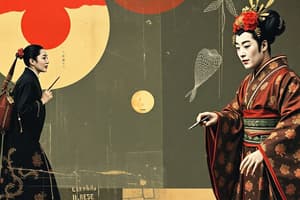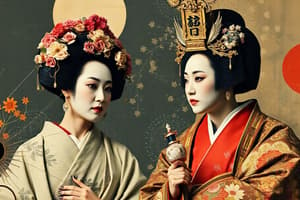Podcast
Questions and Answers
[Blank] is a classical Japanese dance-drama known for its elaborate costumes, makeup, and stylized movements.
[Blank] is a classical Japanese dance-drama known for its elaborate costumes, makeup, and stylized movements.
Kabuki
Kabuki's origins trace back to Izumo no ______, a female shrine dancer who performed innovative dances and skits in Kyoto.
Kabuki's origins trace back to Izumo no ______, a female shrine dancer who performed innovative dances and skits in Kyoto.
Okuni
During the Edo period, the ______ shogunate implemented strict regulations on Kabuki performances, including content restrictions and performer guidelines.
During the Edo period, the ______ shogunate implemented strict regulations on Kabuki performances, including content restrictions and performer guidelines.
Tokugawa
Kabuki actors use distinctive makeup called ______ to emphasize their characters and emotions; the colors and patterns of the makeup hold symbolic meanings.
Kabuki actors use distinctive makeup called ______ to emphasize their characters and emotions; the colors and patterns of the makeup hold symbolic meanings.
[Blank] are male actors who specialize in playing female roles in Kabuki.
[Blank] are male actors who specialize in playing female roles in Kabuki.
[Blank] (historical plays) depict events from Japan's feudal past, often featuring samurai warriors, noble families, and political intrigue.
[Blank] (historical plays) depict events from Japan's feudal past, often featuring samurai warriors, noble families, and political intrigue.
[Blank] (domestic plays) focus on the lives of common people, exploring themes of love, betrayal, family honor, and social conflict.
[Blank] (domestic plays) focus on the lives of common people, exploring themes of love, betrayal, family honor, and social conflict.
Kanadehon Chushingura also known as The Treasury of 47 **______** is a historical drama about a group of samurai who avenge the death of their lord.
Kanadehon Chushingura also known as The Treasury of 47 **______** is a historical drama about a group of samurai who avenge the death of their lord.
Yoshitsune Senbon Zakura also known as Yoshitsune and the Thousand Cherry **______** is a historical play about the exploits of the legendary warrior Minamoto no Yoshitsune and his loyal followers.
Yoshitsune Senbon Zakura also known as Yoshitsune and the Thousand Cherry **______** is a historical play about the exploits of the legendary warrior Minamoto no Yoshitsune and his loyal followers.
Kabuki was designated as a UNESCO Intangible ______ Heritage in 2008, recognizing its cultural significance and historical value.
Kabuki was designated as a UNESCO Intangible ______ Heritage in 2008, recognizing its cultural significance and historical value.
Flashcards
What is Kabuki?
What is Kabuki?
Classical Japanese dance-drama known for its elaborate costumes, makeup, and stylized movements.
Who is Izumo no Okuni?
Who is Izumo no Okuni?
She was a female shrine dancer who performed innovative dances and skits in Kyoto, credited with Kabuki's origins.
What is Kabuki makeup (kesho)?
What is Kabuki makeup (kesho)?
Emphasizes characters and emotions, using colors and patterns to convey age, gender, social status, and personality.
What are Kabuki movements (kata)?
What are Kabuki movements (kata)?
Signup and view all the flashcards
Kabuki musical accompaniment
Kabuki musical accompaniment
Signup and view all the flashcards
Who are Onnagata?
Who are Onnagata?
Signup and view all the flashcards
What is Kabuki stage design (keren)?
What is Kabuki stage design (keren)?
Signup and view all the flashcards
What are Jidaimono plays?
What are Jidaimono plays?
Signup and view all the flashcards
What are Sewamono plays?
What are Sewamono plays?
Signup and view all the flashcards
Kanadehon Chushingura
Kanadehon Chushingura
Signup and view all the flashcards
Study Notes
- Traditional Japanese theater encompasses a variety of forms, each with distinct characteristics and historical significance
- These include Noh, Kabuki, Bunraku (puppet theater), and others rooted in specific cultural and historical contexts
- Each form combines music, dance, drama, and elaborate costumes/makeup to tell stories and convey emotions
Kabuki
- Kabuki is a classical Japanese dance-drama known for its elaborate costumes, makeup, and stylized movements
- It emerged in the early Edo period (17th century) and gained popularity among the merchant classes
- Kabuki combines elements of Noh, Bunraku, and folk dances, creating a visually stunning and emotionally resonant theatrical experience
Origins and Development
- Kabuki's origins trace back to Izumo no Okuni, a female shrine dancer who performed innovative dances and skits in Kyoto
- Her performances attracted large crowds and gained support from wealthy patrons
- Early Kabuki troupes initially consisted of female performers, but later transitioned to all-male casts due to social and political factors
- During the Edo period, Kabuki theaters flourished in urban centers like Edo (Tokyo), Osaka, and Kyoto
- The Tokugawa shogunate implemented strict regulations on Kabuki performances, including content restrictions and performer guidelines
- These regulations aimed to maintain social order and prevent Kabuki from becoming a platform for political dissent
- Despite the restrictions, Kabuki continued to evolve, incorporating new techniques, themes, and dramatic devices
Key Features of Kabuki
- Elaborate makeup (kesho): Kabuki actors use distinctive makeup to emphasize their characters and emotions
- The colors and patterns of the makeup hold symbolic meanings, conveying information about the character's age, gender, social status, and personality
- Stylized movements (kata): Kabuki movements are highly stylized and choreographed, often drawing inspiration from dance and martial arts
- The movements are designed to convey emotions, tell stories, and create visually striking stage pictures
- Musical accompaniment (nagauta, gidayu-bushi): Kabuki performances feature musical accompaniment from various instruments, including drums, flutes, and shamisen
- The music enhances the dramatic atmosphere, punctuates key moments, and provides emotional context for the audience
- Onnagata (female impersonators): Kabuki is characterized by onnagata, male actors who specialize in playing female roles
- Onnagata undergo rigorous training to master the mannerisms, gestures, and vocal techniques required to portray female characters convincingly
- Stage design and effects (keren): Kabuki stages are known for their elaborate designs, trap doors, and revolving platforms
- The stagecraft includes dramatic entrances and exits, costume changes, and special effects to heighten the theatrical experience
Kabuki Repertoire
- Kabuki plays cover a broad range of topics, including historical events, romantic dramas, domestic disputes, and supernatural tales
- "Jidaimono" (historical plays) depict events from Japan's feudal past, often featuring samurai warriors, noble families, and political intrigue
- "Sewamono" (domestic plays) focus on the lives of common people, exploring themes of love, betrayal, family honor, and social conflict
- "Shosagoto” (dance dramas) place emphasis on dance and movement
Influence and Legacy
- Kabuki has exerted a significant influence on Japanese culture, arts, and entertainment
- Kabuki's stylized movements, makeup, costumes, and music have been adopted in various art forms, including film, anime, and fashion
- Kabuki continues to be performed in theaters across Japan and around the world, attracting audiences of all ages and backgrounds
- Kabuki was designated as a UNESCO Intangible Cultural Heritage in 2008, recognizing its cultural significance and historical value
Notable Kabuki Plays
- "Kanadehon Chushingura" (The Treasury of 47 Ronin): A historical drama about a group of samurai who avenge the death of their lord
- "Yoshitsune Senbon Zakura" (Yoshitsune and the Thousand Cherry Trees): A historical play about the exploits of the legendary warrior Minamoto no Yoshitsune and his loyal followers
- "Kanjincho" (The Subscription List): A drama set during the 12th century about a warrior disguised as a monk
- "Meoto Zenzai": A romantic drama
Training and Performance
- Kabuki actors undergo extensive training from a young age, often within family lineages
- Training includes instruction in dance, music, acting, and stagecraft
- Kabuki performances can last for several hours, with actors performing multiple roles in a single play
Studying That Suits You
Use AI to generate personalized quizzes and flashcards to suit your learning preferences.




